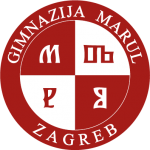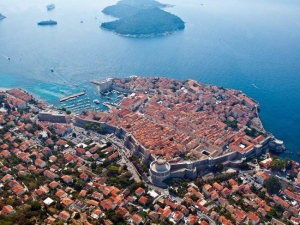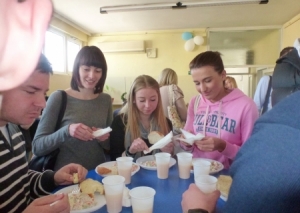O Hrvatskoj i hrvatskom jeziku
„Qual è colui che forse di Croazia viene a veder la Veronica nostra, che per l’antica fame non sen sazia, ma dice nel pensier, fin che si mostra: 'Signor mio Gesù Cristo, Dio verace, or fu sì fatta la sembianza vostra?'“ (Dante, Paradiso, XXXI., 103-108)
„K'o onaj koji iz Hrvatske valjda dolazi našu Veroniku zreti, što je se s davnog ne nasiti glada, u mislima zbori, gledajući: 'Moj Gospode, Isuse Kriste, pravi Bože, je li tvoja slika bila tada kao što ju vidim sad?'“ (Dante, Raj, pjevanje XXXI., stihovi 103-108, prijevod: Mate Maras)
Veronica (vera icona - prava ikona, slika Krista) predstavlja sliku Isusa Krista u nas poznatu kao Veronikin rubac.
Dante je dio svojih putovanja proveo u Hrvatskoj (uključujući i Zagreb, u kojemu je njegov praunuk otvorio ljekarnu). Na tome je putovanju u njegovu društvu bio i hrvatski biskup blaženi Augustin Kažotić..
Hrvatska, zemlja koja je velikom Danteu, neupitnom ocu europske književnosti u smislu današnjih paneuropskih integracija, poslužila kao primjer zemlje iz koje dolaze hodočasnici diviti se Kristovu liku otisnutu na rubac svete Veronike, žene koja mu je na Križnom putu tim rupcem obrisala krvavo, znojno i ispljuvano božansko lice. Hodočasnici su iz Hrvatske oni koji dolaze na izvor svetosti, kulture i znanja – u Rim. Današnjim rječnikom reklo bi se – oni koji čvrsto koračaju putem europskih integracija. Dakle, Dante uzima Hrvatsku kao primjer daleke i nerazvijene zemlje koja se čvrsto opredijelila biti dio zapadnoga kulturalnog svijeta. To što je Danteovu izboru Hrvatske pripomogla i odgovarajuća rima (Croazia – sen sazia) nimalo ne umanjuje znakovitost ni važnost toga izbora. Hrvatska će taj status ubrzo i dokazati svojim nadimkom „Antemurale Christianitatis“ (Predziđe kršćanstva), koji je stekla krvavom borbom i žrtvom na braniku europskih i kršćanskih vrijednosti pred najezdom Osmanlija. Sve to napominjemo zato što u nekim zapadnoeuropskim krugovima postoji uporna i zlobna tendencija omalovažavanja pa čak i ignoriranja Hrvata. Ta tendencija traje do najnovijeg doba, do velikosrpske agresije na Hrvatsku, agresije koju su ti krugovi zdušno podupirali. Zato je dobro znati da je jedan od najvećih Europljana, Dante Alighieri, još početkom XIV. stoljeća dobro znao tko su Hrvati i gdje je Hrvatska, za razliku od, primjerice, velikomađarskog političara Lajosa Kossutha, prepotentnog udvorice tim istim zapadnoeuropskim krugovima, koji u XIX. stoljeću „nije vidio Hrvatsku na zemljovidu“ i, za razliku od isto tako prepotentnih tužitelja i sudaca u prvom razdoblju djelovanja Haaškoga suda, koji su Hrvate optuživali i osuđivali naprosto zato što se usuđuju biti Hrvati. Isti ti prepotentni zapadnoeuropski krugovi postojali su još davno.
Hrvatski plemić grof Vuk Frankopan održao je pred carem Karlom V. i njemačkim staležima, u Augsburgu, znamenit govor 1530. god. zalažući se za obranu ostataka ostataka negda slavnoga Hrvatskoga kraljevstva (Ivo Frangeš, Povijest hrvatske književnosti). I kakva je bila reakcija Europe na njegov očajnički krik i poziv u pomoć? Nikakva. Potpuno ignoriranje. Kao i 1991. Zato je lijepo znati da su nas oni najveći uvijek prepoznavali. Kao Dante Alighieri. Kao sveti Ivan Pavao II. Kao Alain Finkielkraut, francuski filozof. Kao Marco Pannella, vođa Transnacionalne radikalne stranke, koji je već prve dane agresije solidarno s hrvatskim braniteljima proveo u rovovima u Osijeku. Kao Alois Mock. Kao Hans-Dietrich Genscher. Kao majka Terezija. I kao, na kraju krajeva, najveći današnji Rus, dugogodišnji svjetski šahovski prvak Gari Kasparov, koji je, po vlastitu priznanju, stao na hrvatsku stranu iz jednostavna razloga što je Hrvatska napadnuta. I u razdoblju između dvaju svjetskih ratova sramotnu je šutnju bijeloga svijeta poslije ubojstva Stipice Radića prekinuo jedan od najvećih – Albert Einstein – napisavši u newyorškom tisku članke koji raskrinkavaju zločine karađorđevićevske dinastije, koju je ta ista pokvarena Europa jako cijenila.
Nije nam namjera spekulirati na tragu nekakve teorije zavjere protiv Hrvata. Naprotiv, želimo naći racionalan uzrok toga ignorantskog stajališta Europe naspram Hrvatske. Taj razlog leži u činjenici da smo maleni. Hrvatska je mala i hrvatski je narod malen. No, je li baš tomu tako? Istina, zemlja nije velika, ali je veća i od Švicarske i od Belgije i od Nizozemske i od Danske (bez Grenlanda, naravno) i od Slovačke, a nitko o spomenutim zemljama ne razmišlja prvenstveno na osnovi njihove nevelike površine. Tome stajalištu bijeloga svijeta pridonijeli smo, kao i u mnogim sličnim slučajevima, i mi sami nekakvim čudnim kompleksom manje vrijednosti. Još se dobro sjećamo one nespretne nekadašnje promidžbene krilatice hrvatskog turizma „Mala zemlja za veliki odmor“. Zašto „mala“? Kao da je to bitno. Bitan je velik odmor, a kolika je površina zemlje sasvim je sporedno. I tako se događa da ljudi dolaze u Hrvatsku s fiksnom idejom da je minijaturna, a neki se od njih zatim iznenade, kao onaj Kanađanin na tečaju hrvatskoga jezika u Vodnikovoj koji je zbog nekog razloga morao autom putovati od Osijeka do Dubrovnika. I, došavši negdje do pola puta, kod Zagreba, kaže on sebi: „Pa velika je to zemlja!“
Što se tiče stanovništva, ono je u zemlji doista malobrojno, ali, kao prvo, na ulicama gradova to se ne opaža, uvijek je gužva, i u velikim i u malim gradovima. Kao drugo, neke zemlje, kao što su Norveška, Danska, Irska, Škotska i Slovačka, imaju jednako toliko ili neznatno više stanovnika pa nitko o njima ne govori kao o demografski siromašnim zemljama. A budući da velik broj pripadnika hrvatskoga naroda živi u susjednoj Bosni i Hercegovini i budući da su oni životno i boravišno vezani za Hrvatsku, a mnogi od njih imaju i dvojno državljanstvo, realan je broj Hrvata u Hrvatskoj zapravo veći od broja stanovnika u navedenim europskim zemljama. I, kao treće, neizmjerno mnogo Hrvata živi u iseljeništvu, u zapadnoj Europi, u Sjevernoj Americi, u Južnoj Americi, u Australiji, a i u Južnoafričkoj Republici. A ti su ljudi duboko povezani sa starom domovinom, često putuju u nju i najčešće odgajaju djecu u hrvatskom duhu. U iseljeništvu vjerojatno ima više Hrvata nego u domovini. Tako da nije čudno da je predsjednik hrvatske vlade došao iz iseljeništva, iz Kanade. A postoji i jedna anegdota iz Kanade: Stoji Manda (Ličanka) pred svojom kućom u Torontu, prolazi jedan stariji Indijanac i pita je gdje je u tome dijelu grada ured za skrb o Indijancima. Ona mu objašnjava, a on će:
- Madam, where are you from?
- Why do you ask?, pita Manda.
- Because you talk exactly like my father.
- And where was your father from?, upita Manda.
- I don't know but he always mentioned Lika, kaže Indijanac.
(- Gospođo, odakle ste?
- Zašto me to pitate?, pita Manda.
- Zato što govorite baš kao i moj otac.
- A odakle je bio Vaš otac?, upita Manda.
- Ja ne znam, ali je često znao reći "Lika", kaže Indijanac.)
To je sudbina mnogih Hrvata.
A hrvatski gradovi? Posebna je to priča. Rijetko se koja zemlja može pohvaliti tolikim brojem lijepih i zanimljivih gradova. Svi se još sjećamo (mi malo stariji) poznatoga govora pokojnoga pjesnika Vlade Gotovca na Krešimirovu trgu u Zagrebu, u vrijeme prvih bombardiranja Osijeka i Vukovara. „Pa kad vi pogledate Osijek, vidite kako je taj grad izgrađen u najreprezentativnijem stilu zapadnoeuropske arhitekture tako da on, kao i ostali hrvatski gradovi, predstavlja svjedočanstvo naše pripadnosti europskom kulturnom krugu. Stoga neprijatelj želi satrti i uništiti tu arhitekturu kako bi s osvojena područja izbrisao tragove naše uključenosti u zapadnu Europu“ (citirano po sjećanju).
Veliki su hrvatski gradovi raspoređeni zrakasto u odnosu na metropolu, koja je, zbog geopolitičkih i povijesnih razloga, smještena u samom sjeverozapadnom kutu zemlje. Od Zagreba se šire tri zrake – jedna jugozapadna prema Rijeci, glavnom gradu Kvarnersko-goranske regije, jedna južna prema Splitu, glavnom gradu Dalmacije i drugom po veličini gradu u Hrvatskoj, i treća, istočna, prema Osijeku, glavnom gradu Slavonije i Baranje. Postavlja se pitanje koji je hrvatski grad najljepši. Svi su hrvatski gradovi lijepi, od Iloka, preko Županje, Čakovca i Samobora, do Umaga, Metkovića i Cavtata, da navedemo samo one rubne, granične ili gotovo granične manje gradove. No, budući da je zapravo glavna posebnost Hrvatske to naše Jadransko more, „Mare nostrum croaticum“, prirodno je očekivati da je najljepši hrvatski grad smješten na moru. I nekako je uobičajeno, zbog njegove prekrasne srednjovjekovne arhitekture, zbog zidina koje mu daju zaokruženost i zbog njegova idealnog položaja između mora i Srđa, Dubrovnik smatrati najljepšim hrvatskim gradom. No, recite vi to Splićanima! Ne'eš ti! Baš kao u onoj pjesmi, sveti Duje ne će ni da čuje. A uostalom, najveća suvremena dubrovačka pjevačica Tereza Kesovija ovjekovječila je svojim glasom da „Nima Splita do Splita“ i da „Od svih mista na svitu najlipši je Split“ – grad izrastao iz starorimske carske ladanjske palače. No, tu je i Zadar, koji je, prije negoli je Split to postao zahvaljujući veličini, industriji, prometnoj i brodarskoj važnosti, u doba kada je Dalmacija imala politički identitet, bio glavni grad Dalmacije i u njemu je zasjedao Dalmatinski sabor. I da grad nije teško stradao uslijed divljačkih savezničkih bombardiranja za vrijeme Drugoga svjetskog rata, moglo bi se s pravom reći da je Zadar najljepši hrvatski grad. A nedavno je na Hrvatskoj televiziji kandidat u kvizu znanja, upitan iz kojega je grada, odgovorio: „Iz najljepšeg grada na Jadranu“. „A koji je to?“ „Znam da će se Dubrovčani i Splićani naljutiti, ali za mene je to Šibenik“. I kada pogledamo slike Šibenika kako okružen zelenilom izlazi iz mora, a u spletu lijepih starih kuća crvenih krovova ponosno se koči najljepši pojedinačni spomenik hrvatske arhitekture, katedrala sv. Jakova graditelja Jurja Dalmatinca, mora se priznati da čovjek ima pravo. A i Rijeka ima svoje adute, kao najurbaniji hrvatski grad, s golemom lukom, rijekom Rječinom, kozmopolitskim Korzom i divnim velikim palačama u luci i oko nje. Svakako i Osijek, iako nema mora, ima plovnu Dravu, brodove na njoj i plaže uz nju, prvi tramvaj u Hrvatskoj, staru četvrt Tvrđu i najuređenije središte u smislu zapadnoeuropskog urbanizma secesijskoga stila. A tek istarski biseri, Pula s Arenom i drugim rimskim spomenicima i sa sjajnom historicističkom arhitekturom u središtu grada, pa zatim gradići u unutrašnjosti poluotoka, dok na priobalni Rovinj, Poreč i Labin ne treba ni trošiti riječi. A na sjeveru je Varaždin, „pričuvni glavni grad Hrvatske“, grad baroka i slikovitih srednjoeuropskih crkava, te urednih ulica i trgova kao stvorenih za „španciranje“.
A svi oni dragulji – gradovi i gradići na obali Jadrana i na otocima? Od Lovrana i prve turističke ljepotice Opatije preko Crikvenice, Krka i njegove katedrale, Omišlja, Malinske, Vrbnika i Baške, do Raba, njegove katedrale i njegovih zvonika te Lopara, preko Cresa, Osora i njegove katedrale, Velog Lošinja, Senja, Karlobaga, Paga i Novalje, Nina i njegovih starohrvatskih crkvica, Preka i Kali na Ugljanu, Pakoštana, Biograda, Vodica, Tkona na Pašmanu, Prvića, Primoštena, Zlarina, Sali na Dugom otoku, Murtera, Tribunja, Rogoznice,Trogira i njegove katedrale, Kaštela, Omiša, Makarske i njezine katedrale, Brela i Baške Vode, Zaostroga i Tučepa, gradićâ na Šolti, zatim Supetra, Pučišćâ i Postirâ na Braču, Hvara i njegove katedrale, Jelse i Staroga Grada, Visa i Komiže, Korčule i njezine katedrale, Blata i Vele Luke, gradićâ na Pelješcu – Trpnja i Orebića, gradićâ na Mljetu, Lastova, gradićâ na Šipanu, Lopuda i Lokruma. Ima li tome nabrajanju uopće kraja? A svaki od navedenih gradova i gradića dragulj je sredozemne arhitekture u rajskom okružju mora i bujne mediteranske vegetacije.
Pri tome nabrajanju primorskih dragulja ostali su pomalo zaboravljeni mnogi gradovi i gradići velike povijesne i kulturalne važnosti na kontinentu, pa je red da i njih spomenemo: Solin s rimskim i starohrvatskim arheološkim spomenicima, Sinj sa svojom Alkom i poznatim marijanskim svetištem, Imotski sa svojom prekrasnom gradskom jezgrom, zatim Drniš, također u unutrašnjosti Dalmacije, kao i Knin sa svojom velebnom tvrđavom kralja Zvonimira, zatim Pazin, Buzet, Beram, Grožnjan, Motovun i Buje u unutrašnjosti Istre, Gospić, glavni grad Like, Delnice, Slunj, Duga Resa, Karlovac i njegove četiri rijeke, Petrinja, Ivanić-Grad, Krapina, Klanjec, Marija Bistrica s glasovitim marijanskim svetištem, Križevci s grkokatoličkom katedralom, Ludbreg, Koprivnica, Kutina, Sisak sa svojom katedralom i lukom na Savi i na Kupi, Nova Gradiška, Bjelovar sa svojom katedralom, Daruvar sa svojim toplicama, Lipik, Požega sa svojom katedralom i slikovitim glavnim trgom, Pitomača, Virovitica, Našice, Slavonski Brod i njegova luka na Savi, Slatina, Vinkovci, Orahovica, Gunja, Đakovo sa slavnom Strossmayerovom katedralom, Beli Manastir i grad-heroj na Dunavu – Vukovar.
A naša metropola? Prebogata riznica pjesama posvećenih Zagrebu dovoljno svjedoči o tome koji se grad najviše ima rad i koji je „najlepši nam grad“.
A može li se govoriti o ljepotama Hrvatske bez spominjanja njezinih nacionalnih parkova i parkova prirode, od svjetski poznatih Plitvičkih jezera do Kornatskog otočja, od Brijuna do Mljeta, od Velebita i Paklenice do slapova Krke, od Risnjaka do Medvednice, od Učke do Lonjskog polja, od Telašćice do Lastovskog otočja, od Vranskog jezera, preko Žumberka i Samoborskoga gorja do bujne prirode Kopačkoga rita?
O hrvatskom jeziku
U tebi sam vijek svoj proživio,
Drevni i lijepi jeziče Hrvata:
Rođen na morskom pragu tvojih vrata,
Polako sam te, uz trud, osvojio.
(Vladimir Nazor, Hrvatski jezik)
„To što mi Hrvati (najtipičniji malograđanski politički kverulanti na globusu) imamo uvijek pravo, to je upravo ono naše „Hrvatsko Pravo“, koje je dalo purgarima Hrvatima našu pravašku svijest. Međutim, doista je glupo devet stotina godina gubiti parnice, a imati pravo! Hrvati primaju krst iz Rima, a postaju glagoljaši, i ta proturimska, glagoljaška tvrdoglava upornost znači zapravo prvu organiziranu narodnu pobunu u okviru rimske crkve, u vremenu kada o narodnosti u Europi još nitko nije ni sanjao.“
(Miroslav Krleža, Deset krvavih godina)
Nisu Hrvati izmislili glagoljicu. Izmislila su je sveta braća Ćiril i Metod, slavenski misionari. No, Hrvati su glagoljicu najzdušnije prihvatili kao izraz svoga nacionalnog identiteta „u vremenu kada o narodnosti u Europi još nitko nije ni sanjao“, kao što kaže Krleža. Osim toga, Hrvati su jedini od slavenskih naroda glagoljicu doveli do likovno-estetskog savršenstva, počevši od Bašćanske ploče (oko 1100. godine) do prelijepih višebojnih iluminacija u Hrvojevu misalu (početak XV. stoljeća) i zadivljujućih inkunabula s kraja XV. stoljeća, kao što su Hrvatskoglagoljaški misal i Kosinjski brevijar (vidi prekrasne ilustracije u Frangešovoj Povijesti hrvatske književnosti). Hrvati su toliko prihvatili glagoljicu da su Česi, dakle oni kojima je to pismo prvotno bilo namijenjeno, u XIV. stoljeću pozivali hrvatske glagoljaše u Prag kako bi poučavali glagoljicu u njezinoj hrvatskoj, uglatoj inačici.
Zlatno doba hrvatske glagoljaške književnosti (po prilici od 1075. do 1475.) stvorilo je jedinstvenu enklavu pučkog jezika unutar zapadnog kršćanstva (Ivo Banac, Hrvatsko jezično pitanje).
Od robstva bi davno u valih
Potonula Italija
O Harvatskijeh da se žalih
More otmansko ne razbija.
(Vladislav Menčetić [1617.-1666.], dubrovački pjesnik, Trublja Slovinska)
U doba „ostataka ostataka“, dakle u doba najveće redukcije hrvatskog suvereniteta, Dubrovačka je Republika predstavljala jedinu luč neprekidna trajanja toga suvereniteta. Stoga nije čudno da je Bartol Kašić(1575. – 1650.), pisac prve hrvatske gramatike, isusovac podrijetlom iz čakavskog Paga (Ivo Banac, Hrvatsko jezično pitanje), izabrao upravo dubrovački govor za temelj svoje slovnice, nakon što se boraveći u Dubrovniku dobro upoznao s tim govorom. A osim toga, kao što kaže Banac, „crkveni učenjaci su sve više priznavali štokavski kao najznačajnije hrvatsko narječje“ iako je temeljno djelo hrvatske književnosti, Marulićeva Judita, napisano na ikavskoj čakavici. Razmatrajući problematiku neobjavljivanja Kašićeva prijevoda Biblije na isti taj ijekavsko-štokavski govor hrvatskoga jezika, Marko Grčić piše:
„(…sklonio) papu Urbana VIII. da ne dopusti njezino objavljivanje. Argument mu je, ukratko, bio da je knjiga prevedena na dubrovački i da se stoga izvan tamošnje biskupije ne će moći ni čitati. To, međutim, tvrde stručnjaci, nije bilo točno: već i površan uvid u Kašićev prijevod kazuje, naime, da je on imao, kao što pronicavo opaža akademik Radoslav Katičić, pred očima budućnost zajedničkoga jezika Hrvata – kojoj bi njegov pothvat mogao biti tek početak – a ne puka stilizacija prošlosti nekoga od dijalekata, ili pak njihova sinkretizma.“
(Marko Grčić, Riječi, riječi, riječi).
Malo-pomalo, Kašićevo je načelo prihvaćeno i dobilo snažan vjetar u leđa Gajevom reformom sjeverozapadnoga, kajkavskog hrvatskog književnog jezika i proglašavanjem dubrovačkih klasika uzorima dobra pisanja. A ostalo, Novine horvatske, Danica horvatska, Mihanović i Horvatska domovina, to ostalo je – povijest. Povijest koja završava stvaranjem slobodne hrvatske države.
Kao što kaže bard hrvatske književnosti, Slobodan Novak, citirano također iz knjige Marka Grčića Riječi, riječi, riječi: „Novak je nedvosmislen: 'Ja sam iskreno iskazivao svoje poštovanje ličnosti i djelu osnivača slobodne hrvatske države, Franji Tuđmanu, i osjećam duboku zahvalnost tomu hrvatskom velikanu, bez ikakvih naivnih iluzija o njegovoj nepogrješivosti i nadzemaljskoj čistoći, i bez ikakva strančarenja. S jedinim žaljenjem što mu sudbina nije dala vremena da nam državu zaštiti od globalizacije, onakve kakvu, čini se, priželjkuju veliki, da zaštiti našu nezavisnost od fiktivne Europe, a Domovinski rat od haaškoga Usuda i njegove sramotne pravde.'“
Bogu hvala, sudbina je Slobodanu Novaku i svima nama dala vremena da doživimo oslobađajuću presudu generalima Gotovini i Markaču na Haaškome sudu. U smislu onih Krležinih devetsto godina gubljenja parnica iako smo u pravu, poslije gotovo tisuću godina Hrvatska je na bjelosvjetskom sudištu napokon dobila jednu parnicu. I to ne bilo kakvu. Onu najveću.








